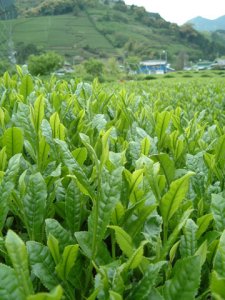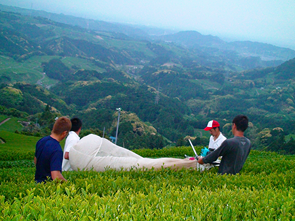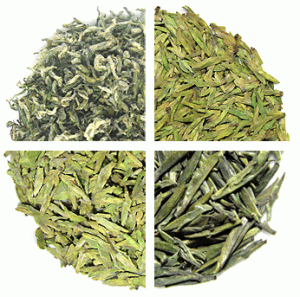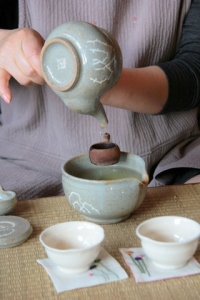In the distant days of pre-history, forest-dwelling inhabitants experimented with cooking the leaves and buds plucked from wild-growing tea trees in the far Western regions of China. Since that time, tea has developed over the centuries into a refined and elegant beverage: the drink of emperors, monks and every man.
China was the first country to understand the value of the leaves of indigenous Camellia sinensis and Camillia assamica tea bushes – first as a food source, then as a medicinal tonic and lastly as a refreshing beverage. Centuries were spent cultivating vast numbers of teas in the mountainous regions of China, and in refining methods for preparing tea. Exquisite teawares were created to showcase this precious beverage, adding a tactile and visual element to social tea gatherings.

Imperial Tribute Teas / Famous Chinese Tea
Fortunately for us today, many of these historic teas survive. Once known as Imperial Tribute Tea (teas once favored by various ruling emperors) today these teas are known as Famous Chinese Teas.
Beginning in China’s Tang dynasty (618-907) and continuing into the Song dynasty
(960-1279) certain teas became renowned for their elegance and refinement. Plucked in the cool, misty days of early spring from isolated tea gardens in lofty mountain regions, these teas were promoted as elixirs of the gods. Each tea was of such remarkable and ethereal quality that successive emperors claimed production of certain teas as his exclusive property. Emperors took delivery of the tea as soon as it was available in the spring, which was recorded as fulfillment of ‘tax’ owed to the government. Hence the name ‘tribute’. The fine reputation of these teas from revered mountains were also known to tea connoisseurs and the literati in the Song dynasty, who praised the sublime nature of these teas and sipped them from fine, delicate tea bowls.
The Imperial Tribute Teas lost their emperors in 1911, but the teas became available to more tea drinkers in China. And their moniker changed to Famous Chinese Teas. The reputation of these teas has survived both the Cultural Revolution and modernization in Chinese drinking habits and they still remain famous and revered today.

Each Famous Chinese Tea is instantly recognizable by its characteristic leaf shape and size, appearance and taste. These are ‘named’ teas, that is teas that are named for their respective mountain source or place of origin. Their pedigree comes not only from their past imperial association but also from each tea’s unique environment – terroir – and the specific cultivation and steps of leaf manufacture that creates its distinguished character.
It is easy to understand why these teas gained imperial favor – each is an example of a regional specialty tea, unlike no other and made no where else in China. And made just once-a-year for a short one, two or three weeks each spring.
Many of these teas are classified as pre-Qing Ming teas, which means that they are made from the first budding tea bushes of spring (from mid-March to April 5th). Accordingly, pre-Qing Ming teas are more costly than tea that is plucked a few weeks later. These teas are in limited supply because the number of pluckable buds on newly sprouting tea bushes is very small.
Tea enthusiasts in China have published various lists of the Top 10 or Top 15 Famous Chinese Teas. The trouble is that there are so many well-known, beloved teas in China that these lists do not always feature the same teas.
So in the spirit of list-making, the following is Tea Trekker’s list of Top 15 Famous Chinese Teas, based on an aggregation of other lists and what we have gleaned from visiting our tea producers in the various tea-growing regions of China.

The bold-faced teas in this listing are the Famous Chinese Teas from the 2016 harvest that will be arriving at Tea Trekker in April and May. In some cases, such as Keemun, Da Hong Pao, Longjing, Pu-erh and Tieguanyin we will have more than one tea of that type. This is possible as we source micro-lots of tea from different villages with slight differences in manufacture, sub-varietal specificity, etc. Please visit the respective listings pages for these teas to read about each of them and check back frequently to see what has arrived!
- Longjing – Xi Hu Longjing (green tea) – arriving mid-April
- Bi Lo Chun ( green tea) – arriving early April
- Huang Shan Mao Feng (green tea) – on the way to us NOW!
- Jun Shan Yin Zhen (yellow tea)
- Keemun (black tea) – arriving mid-April
- Da Hong Pao (oolong) – arriving late April
- Liu An Gua Pian (green tea) – arriving mid-May
- Tieguanyin (oolong) – arriving early May
- Tai Ping Hou Kui (green tea) – arriving mid-May
- Xin Yang Mao Jian (green tea)
- Yin Zhen (white tea) – arriving mid-April
- Pu-erh – arrives throughout the year
- Lu Shan Yun Wu (green tea) – arriving mid-April
- Ding Gu Da Fang (green tea)
- Mengding Mountain Gan Lu (green tea) – arriving approx. mid-April






 MAY
MAY 











